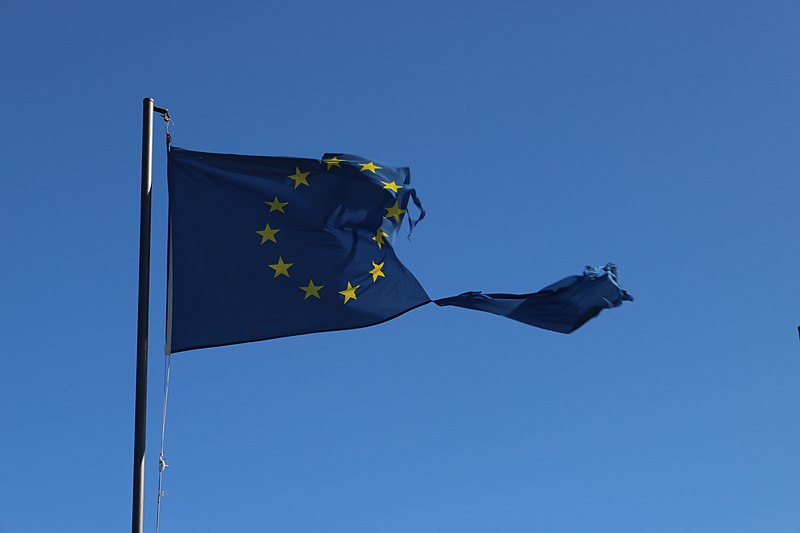 A tattered European Union flag, 2017. Photo courtesy of Derek Bennett via Wikimedia Commons.
A tattered European Union flag, 2017. Photo courtesy of Derek Bennett via Wikimedia Commons.
The Fragmented Union: Why The European Union Needs a Cohesive Defense Network
Vladimir Putin’s tour of the Russian-occupied Ukrainian city of Mariupol sent shivers throughout Europe as his visit to the war zone echoed Adolf Hitler’s tour in 1941. With autocracy waging war at its doorstep, the European Union struggles to keep up with Ukrainian ammunition demand; and states like Poland and Slovakia have begun transferring fighter jets without wider EU or NATO support. European leaders have pushed for an EU bloc strategy regarding defense and global power projection. However, the fragmentation caused by member states’ national defense strategies and agendas complicates EU efforts to unite under one defensive banner. The EU must better unite as a bloc under a cohesive defense network to ensure a Ukrainian victory, the security of the EU, and its member states’ sovereignty and ideals.
At the onset of the war in Ukraine, for the first time in its history, the EU provided lethal aid to a state in active conflict. This reaction to what some EU leaders call an “existential threat to Europe” is a step toward a cohesive EU defense. However, policy differences between EU states that push for more commitment to Ukraine, like Poland and the Baltics, and other states that promote a measured approach to aid, like Germany and France, complicate a unified strategy. Presently, the EU is preparing to provide €1 billion in financial incentives for member states who send ammunition to Ukraine and another €1 billion for new procurement strategies. This is a step forward, but complications are still present, with France demanding that only defense contractors inside the EU get contracts, while criticism from other member states says this will hurt war efforts.
Years before the invasion, a 2017 European Commission compared the EU’s scattered defense network to the United States; the EU had twenty types of fighter planes to the U.S.’ six, twenty-nine varieties of naval destroyers and frigates compared to four, and seventeen main battle tanks to the U.S.’ one. Complicating coordination further is each state’s national defense interests which come before an interest in collective EU defense. Max Bergmann and Sophia Besch describe this as “25 different Pentagons” in their Foreign Affairs essay. This problem has been on the minds of European leaders, primarily French president Emmanuel Macron and former German Chancellor Angela Merkel, who, in 2018, pushed for a streamlined EU defense network that would incentivize and promote member states to coordinate defenses. However, questions remained on whether member states would buy into the idea of better EU defense coordination.
Despite years of discussions concerning a defensive bloc, national governments still pursue their own aid strategies while complicating others. This is illustrated well by the EU sending multiple types of armored vehicles to Ukraine; French AMX-10 armored fighting vehicles, German Schützenpanzer Marder 1 infantry fighting vehicles, British Challenger 2 tanks, and German Leopard 2s. Each design has unique maintenance and supply-chain requirements, complicating Ukrainian efforts to maximize their potential if sent in small numbers. Additionally, EU states like Poland, which wanted to send their Leopard tanks to Ukraine, suffered from weapons re-export restrictions that required German approval. This revealed the weakness of the EU’s current defensive structure: one member state could hold back the entire bloc’s ability to provide tanks and risk Ukrainian war efforts.
Last year, the European Commission published a strategy plan and roadmap for a “Stronger European defence” in response to Russia’s invasion of Ukraine. The plan outlines the need to coordinate research and development of new defense technologies, develop a “common strategic vision,” and reinforce the EU defense industry through joint procurements. The EU is preparing to exercise these plans to address Ukraine’s ammo shortage. The EU plan, as mentioned before, to provide €2 billion in financial incentives and new procurement strategies is a step toward the “stronger European defence” plan and, if proven successful, could catalyze a desire for further change in Europe’s defense landscape. While the plan to unify EU defense is helping Ukraine in the short term, the ultimate goal of this strategy should be to strengthen Europe’s defensive capabilities and prevent an external power from threatening European ideals and territory.
Despite certain universal actions against Russia, like sanctions and lethal aid to Ukraine, the EU still has a severe defense fragmentation problem. To address this, the EU must continue supporting Ukraine while incentivizing national governments to coordinate research and development, production and acquisition, interoperability, and strategic vision. Additionally, eastern EU and NATO states have significant stockpiles of Soviet-era weapons, ammunition, and vehicles. This is uniquely useful for arming Ukraine out of Eastern Bloc legacy arsenals but reveals shortcomings for a common EU defense network that will revolve around modern NATO weapon systems. The war in Ukraine is a wake-up call for the EU—its future as a capable union resides in its ability to unify as a defensive bloc.
Photo licensed under Creative Commons Attribution 2.0 Generic (CC BY 2.0).





